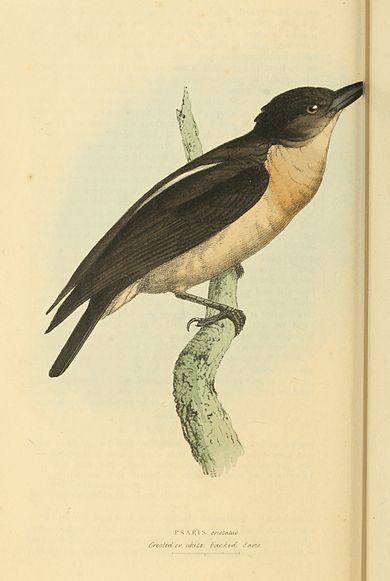Zoological Illustrations Series II/Plate 41
PSARIS cristatus.
Crested or white backed Saris.
PSARIS cristatus.
Crested, or White-backed Saris.
Family Todidæ.—Nobis.
Bill lengthened, depressed, boat-shaped. Tarsi moderate, weak, the three anterior toes more or less united. Wings and tail short.
Sub-family Psariana.—Nobis.
Head very large, depressed. Mouth very wide. Bill thick, depressed, convex above. Feet weak, tarsi rather short, toes united at their base, the outer manifestly longer than the inner; claws broad, compressed; anterior scales transverse; lateral scales small, numerous. The male generally with a spurious quill between the first and second.
Genera.
Psaris. Cuv. Rictus smooth, wings lengthened, the first quill much longer than the fourth, tail short, even.
Type, Psaris Cayanus.—Cuv.
Pachyrhynchus. Spix. Rictus bearded, bill shorter, wings more rounded, tail lengthened, graduated.
Type, Psaris niger.—Nob.
Specific Character.
Blackish brown, beneath pale fulvous, base of the wings with a concealed snowy spot, spurious quill broad, crown black, slightly crested.
Psaris cristatus. Sw. in Zool. Journ. 2, p. 354.
Mus. Paris. Nost.
Of this very rare species we know but of two specimens, both of which appear to have come from the mining provinces of Brazil. The economy of these interesting birds has not yet been detected, even by naturalists who have lived in their native regions. The indefatigable Azara professes his ignorance on this point, but states some valuable information on a species (nearly allied to the Cayenne Saris) named by him Le Distingué a tête Noir, which, in Paraguay, is a bird of passage: its flight is elevated, rapid, and prolonged. "Ils ne sont ni farouches, ni remuans, et ils se tiennent long temps à la même place. Ils ne sortent point des grands bois, et ils se perchent toujours au plus haut des arbres les plus èlevés, où ils ne cherchent pas à se cacher." Azara Voy. 3, p. 407.
The size and strength of the bill induced us, some years ago, to adopt the popular classification of this genus with the family of Shrikes; but a more particular analysis of that and the neighbouring families, lead us to suspect that its natural situation is far different: our reasons for this belief will be stated at large in another work. For the present it may be remarked, that the smoothness of the rictus, as indicating a frugivorous habit, forbids us to place it with the Flycatchers; while the feet, perfectly different from those of the true Shrikes (Laniana, Sw.), can only be compared with those of the Piauhau (Buff.). The affinity which this group bears to Gubernetes, is merely superficial: but its analogies to Ceblepyris, among the Laniadæ, and to Pachycephala, among the Ampelidæ, are probably direct.
The merit of having first directed the attention of Ornithologists to the singular spurious quill, which generally distinguishes the males of this group, we transfer from ourselves to Azara. His invaluable work we did not then possess, and knew not that the circumstance had already been mentioned by him.
We are only acquainted with the genus Pachyrhynchus of Spix, by seeing this name affixed to our Psaris Cuvierii in the Paris Museum. The distinction is judicious; particularly as the two groups point to different relations. Of Psaris, as now restricted, we know of six species, and of Pachyrhynchus, ten.
Our present bird is osculent between these forms: we place it with Psaris on account of its wings and tail; but it accords with Pachyrynchus in the rictus being slightly bristled. The spurious quill is half the length of the first, which latter is as long as the fourth. The tail is in a slight degree rounded. It is, perhaps, needless to remark, that all these birds are confined to Equinoctial America.
